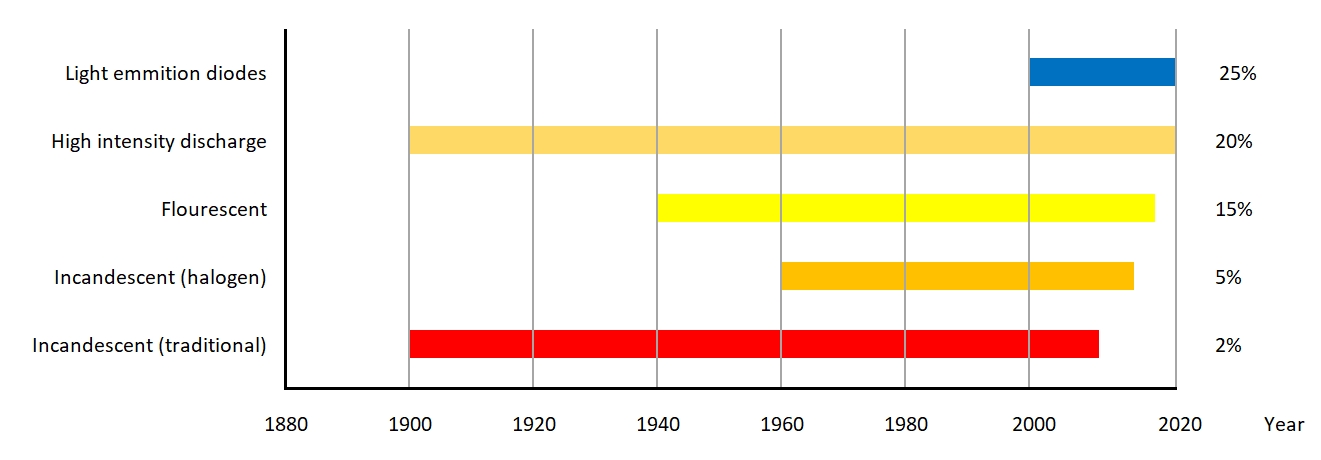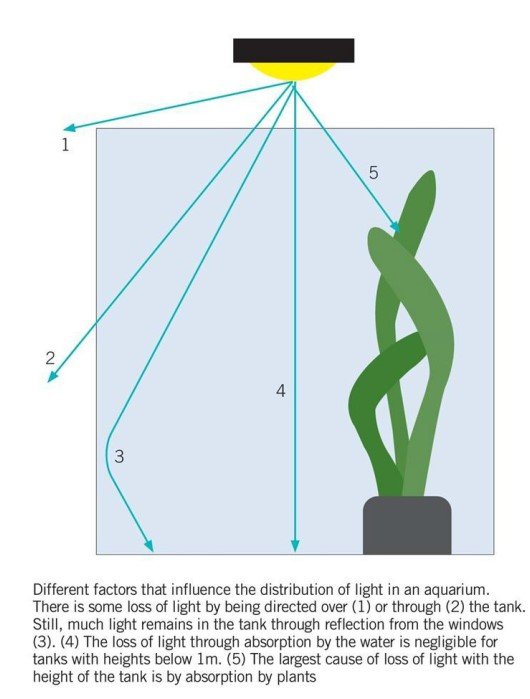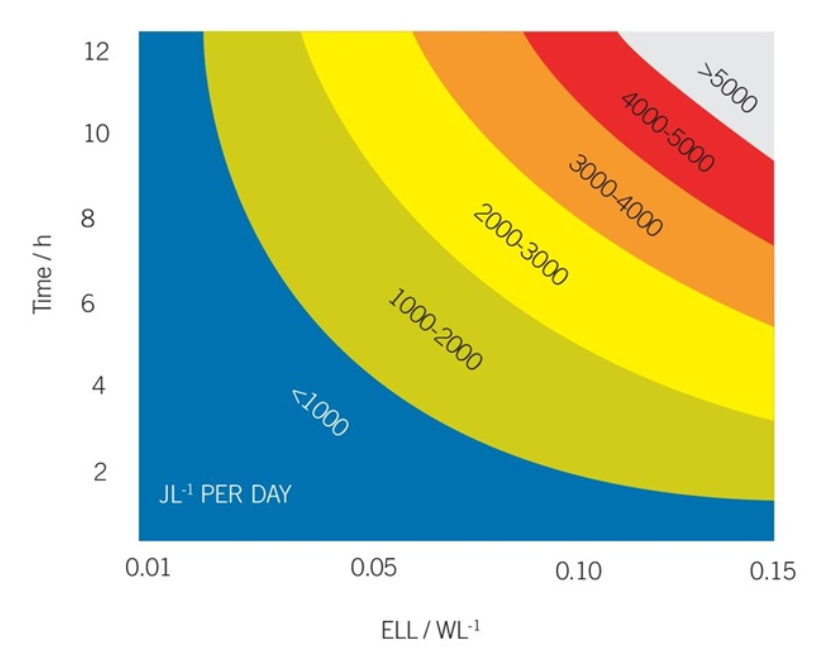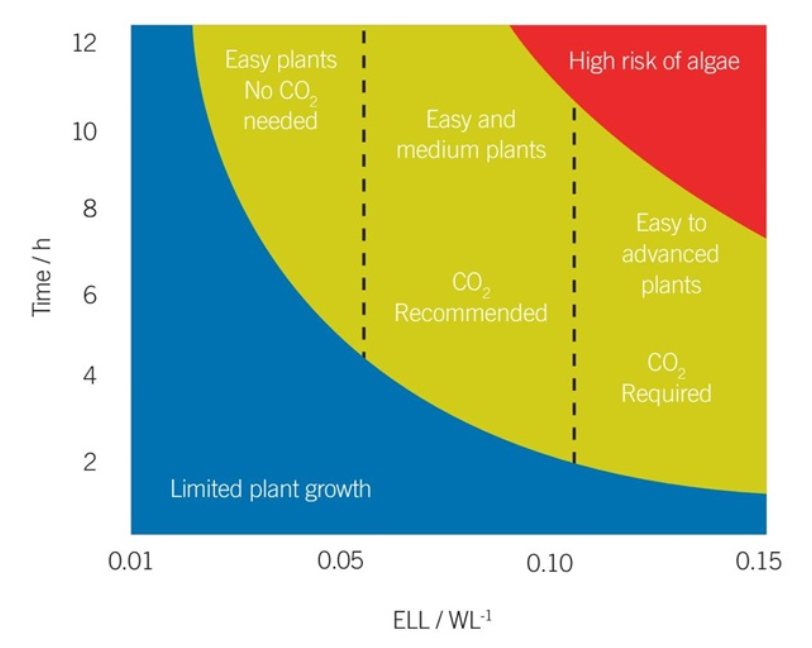Recently I was lucky enough to read a thought-provoking article that makes the case for using lighting wattages to calculate lighting to meet the demands from plants. It was written by Danny Verboekend, a dutch scientist. It can be a bit deep in parts but worth sticking with it if you can.
In essence his article was about technology developments being as important to fishkeeping as they are for autosport. We have come a long way since the lightbulb-lit and metal framed aquarium.
Technological progress has been amazing for aquascaping. In the last 3 decades we have learnt so much. For aquascaping the development of light sources has been enormous.
The basis of any lighting for plants, apart from looking good, is to help plants survive in the best condition. To give them energy. The core task of any light is to convert non-radiative energy (usually electricity) into visible radiative energy (light). We need to look at how efficient the light is at turning electricity into light energy.
The traditional lightbulb has just 2% efficiency. It’s a poor light source, 98% of the energy used by a traditional lightbulb is lost as heat. Only 2% of the electricity is converted to light.
After the traditional lightbulb, came the halogen, fluorescent lighting, metal halide, and light emitting diodes (LEDs), the last of these pushing the lighting efficiency up to 25%.

Then there are the other factors to consider, besides the efficiencies of these different light sources, the ‘spectrum’ and ‘stability’ also varies with each.
Using the ‘Estimative Index’ method of feeding plants it is clear that in order to achieve the best and stable aquascapes, all nutrients need to be present in suitable ranges.
Moreover, they need to be balanced with the light – high-tech energy systems with high levels of lighting need large amounts of nutrients, whereas low-tech tanks with low lighting requires less nutrients.
Contents
Defining low and high
The definition of ‘high’ and ‘low’ are not quantitative. It can be difficult to define and understand.
There are many references relating lighting power to aquarium volume. Some aquarium plant experts recommend at least (0.5 to 1 Watt of lighting per litre) 2.5 to 5 Watt of lighting per gallon.
There are also many others leading the way in plant growing techniques that think a higher limit of (1.25 to 1.5 Watt of lighting per litre) 6.25 to 7.5 Watt per gallon of aquarium water is better.
However, we need to remember that these recommendations are based on fluorescent lighting and are these days becoming pointless as more modern lighting is being used – just consider that a 28W T5 fluorescent lamp is not nearly as bright as a 28W LED light.
To overcome this problem the dutch scientist Danny Verboekend, suggests simply measuring the intensity? But how do you do this without spending your life savings on expensive equipment?
Verboekend proposes a simple estimative method to quantify light intensities.
Estimative Light Load ELL
This method involves correcting the established power-based benchmarks (in Watts per litre) with:
(1) the efficiency of the technology-dependent conversion of electricity into light (ƞ tech), and
(2) the efficiency of its subsequent distribution in the aquarium (ƞ dist).
The resulting quantity can be referred to as the ‘estimative light load’ (ELL):
EQUATION 1

Within equation 1, the power of the light source and volume of the aquarium should be clear, or at worst incredibly easy to calculate. For ƞtech we can rely on the percentages summarized in our light efficiency chart (below). This efficiency is adjusted for each new technology and the ELL could therefore be a long-term indicator.
The ƞdist relates to the amount of generated light that is actually being retained within the tank.
For example, for fluorescent lighting without the use of reflectors, a large part of the generated light (roughly 25%) doesn’t even reach the aquarium. Hence, fluorescent lighting yields a technology efficiency (ƞtech) of 15% and —when situated directly above the tank without reflectors — a distribution efficiency (ƞdist) of 75%, culminating to an efficiency of 11%.
Conversely, LED energy situated directly above the tank (with downward facing projection) has a ƞtech of 25%, a ƞdist of 100%, and an overall efficiency of 25%.
Calculating for aquaria
Traditionally, recommendations on light intensities relate to a certain amount of light expressed in Watts-per-litre or per gallon of aquarium volume.
Does it make sense to divide the light intensity by the aquarium volume?
As the plants and light intensity are usually spread over the width and depth of the tank, a better recommendation would be one which relates to the light intensity on the surface area of the substrate, hence in a light intensity per square meter.
But what about the height of the aquarium?
In a tank without plants, the loss of light with increasing height is minimal. This is due to the negligible absorption of visible light in water – in pure water only 2% of light is absorbed at 39inches (100cm) depth, and the relatively limited amount of light leaving the aquarium due to reflection (see diagram below).

Still, in most tanks the plants grow large, drastically decreasing the average light intensity with the height of the tank.
We can conclude that for most tanks the average light intensity is reduced by the width, depth, and the height of the aquarium. Any attentive readers will notice that width x depth x height equals volume, which means that the expressing light intensity per unit of volume can be justified.
The ELL’s of several commercial set-ups are included in the table below, with values ranging from 0.02 W L -1 to 0.11 W L -1.
Feeding for the light
The next step is linking to the nutrients dosing. As the estimative index (El) was developed for high intensity aquaria, a standard El dosing rate (expressed in the chart on following as one equivalent) would only be relevant to the high light intensity in the table.
Because the demand for nutrients goes down as light levels decrease, the amount of El equivalents needed are reduced in dimmer conditions.
Conversely, at very high light levels the dosing may be increased. Naturally, the higher the light level, the more water changes are needed.
On the other hand, at low lighting the plant selection is more limited. Importantly, the relative influence of natural light is a lot larger in the case of low lighting environment.
Practical application
By multiplying the ELL with the duration that a light source is switched on per day, a daily load of light energy can be calculated. Also, different regimes can be conceived and even visualized.
At very low daily light loads, plant growth is limited, while high light loads risk algal blooms.

Daily estimative light loads displayed as a function of the estimative light load (ELL) and the time a light source is switched on. A regime expressed in Joules is shown (below).

The established guidelines of Tropica of 0.5 W of T5 lighting per liter for Medium® plants (yielding an ELL of O.5xO.15xO.75= 0.06 W L -1) and 1 W of T5 lighting per liter for Advanced® (yielding an ELL of 1xO.l5xO.75=O.11 W L -1) fit the ELL theory (below).

With increasing lighting levels, dosing of gaseous CO2 becomes relevant. For low lighting supplementing with CO2 may not be needed. However, for medium light it is recommended to add CO2, or at least a liquid carbon source, whereas for high lighting dosing gaseous CO2 is usually considered mandatory.
With the ELL, one can easily and effectively estimate the right balance of lighting and nutrients for any type of technology and any tank.


Thomas McCready is the co-founder of Technology Companies that developed many fish tank products such as aquarium heaters and pumps following his passion for keeping fish.

98% of the energy used by a traditional lightbulb is lost as heat?! That’s just nuts! LED all the way for me .. I hate fluorescents… always have.
I always focus so much on the fish, I often forget about the plants – and the fact that they need light. This was very helpful and thanks for making it easy for me to understand.
I enjoy my plants! Got some Mermaid’s Fan arriving in a few weeks.
Nicrew is an awesome brand, had it on my 75 gal tank.
My oscar ate some of the plants I had. It was wild, the guy at the fish store didn’t believe me. I got some java fern and he doesn’t mess with it much luckily.
I believe you! One of the oscars I had back in the day was a hellion! I’m pretty sure it attacked the plants and ate some of them too. Luckily the oscars I got later on were a bit more tame, lol. I love those fish though.
I wasn’t aware that the daily load of light energy can be calculated… or what ELL was… thanks for this! You know so much more than these people working in fish stores who SHOULD be experts as well.
I got a 165W 300W LED full spectrum for my tank. Love it so far!
LED is way better lighting for fish tanks, just for the fact it doesnt heat up the water!
Surprised to see fluorescents have as high of efficiency as they do. Interesting that so much light comes from reflection on the window.
I haven’t had to do math in quite some time! 🙂 This was very helpful though. We have NICREW brand lights and they’ve been fabulous!
Really had never heard that the demand for nutrients goes down as light levels decrease. Interesting!